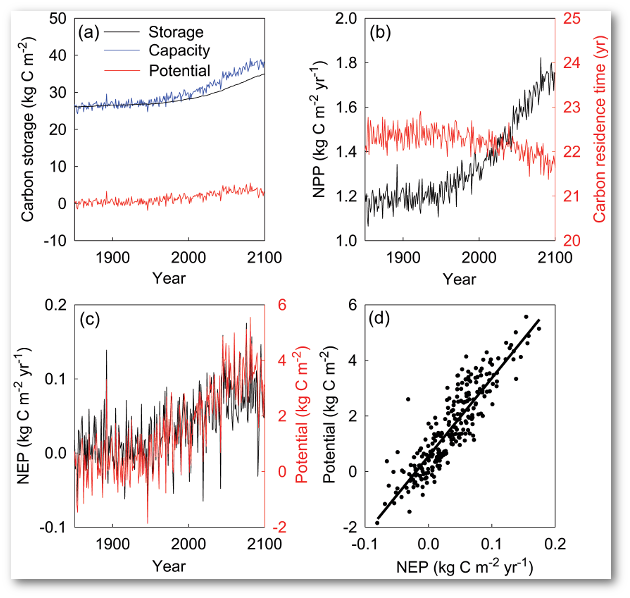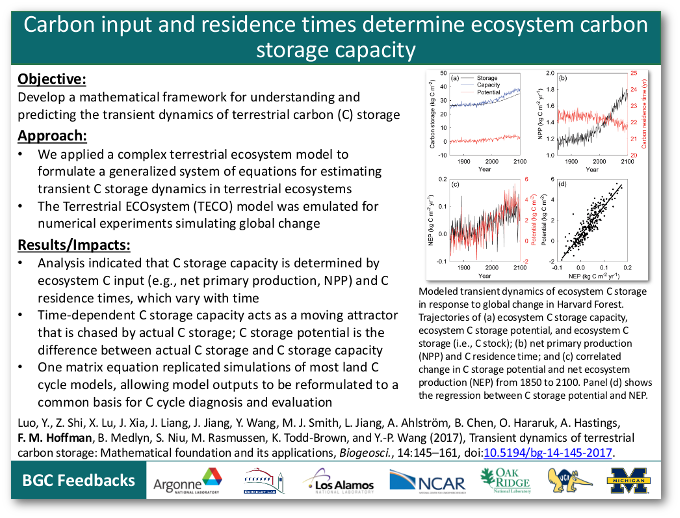Research Highlights
Carbon input and residence times determine ecosystem carbon storage capacity
January 12, 2017
A mathematical framework developed for understanding, diagnosing, and predicting the transient dynamics of terrestrial carbon (C) storage
The Science
We applied a complex terrestrial ecosystem model to formulate a generalized system of equations for estimating transient C storage dynamics in terrestrial ecosystems. The Terrestrial ECOsystem (TECO) model was emulated for numerical experiments simulating global change.
The Impact
Our analysis indicated that carbon (C) storage capacity is determined by ecosystem C input and C residence times, which vary with time. Time-dependent C storage capacity acts as a moving attractor that is chased by actual C storage; C storage potential is the difference between actual C storage and C storage capacity. One matrix equation replicated simulations of most land C cycle models, allowing model outputs to be reformulated to a common basis for C cycle diagnosis and evaluation.
Summary
Terrestrial ecosystems have absorbed roughly 30% of anthropogenic CO2 emissions over the past decades, but it is unclear whether this carbon (C) sink will endure into the future. Despite extensive modeling and experimental and observational studies, what fundamentally determines transient dynamics of terrestrial C storage under global change is still not very clear. Here we develop a new framework for understanding transient dynamics of terrestrial C storage through mathematical analysis and numerical experiments. Our analysis indicates that the ultimate force driving ecosystem C storage change is the C storage capacity, which is jointly determined by ecosystem C input (e.g., net primary production, NPP) and residence time. Since both C input and residence time vary with time, the C storage capacity is time-dependent and acts as a moving attractor that actual C storage chases. The rate of change in C storage is proportional to the C storage potential, which is the difference between the current storage and the storage capacity. The C storage capacity represents instantaneous responses of the land C cycle to external forcing, whereas the C storage potential represents the internal capability of the land C cycle to influence the C change trajectory in the next time step. The influence happens through redistribution of net C pool changes in a network of pools with different residence times.
Moreover, this and our other studies have demonstrated that one matrix equation can replicate simulations of most land C cycle models (i.e., physical emulators). As a result, simulation outputs of those models can be placed into a three-dimensional (3-D) parameter space to measure their differences. The latter can be decomposed into traceable components to track the origins of model uncertainty. In addition, the physical emulators make data assimilation computationally feasible so that both C flux- and pool-related datasets can be used to better constrain model predictions of land C sequestration. Overall, this new mathematical framework offers new approaches to understanding, evaluating, diagnosing, and improving land C cycle models.
Objective
Develop a mathematical framework for understanding and predicting the transient dynamics of terrestrial carbon (C) storage
Approach
- We applied a complex terrestrial ecosystem model to formulate a generalized system of equations for estimating transient C storage dynamics in terrestrial ecosystems
- The Terrestrial ECOsystem (TECO) model was emulated for numerical experiments simulating global change
 |
Figure: Modeled transient dynamics of ecosystem C storage in response to global change in Harvard Forest. Trajectories of (a) ecosystem C storage capacity, ecosystem C storage potential, and ecosystem C storage (i.e., C stock); (b) net primary production (NPP) and C residence time; and (c) correlated change in C storage potential and net ecosystem production (NEP) from 1850 to 2100. Panel (d) shows the regression between C storage potential and NEP. |
Results/Impacts
- Analysis indicated that C storage capacity is determined by ecosystem C input (e.g., net primary production, NPP) and C residence times, which vary with time
- Time-dependent C storage capacity acts as a moving attractor that is chased by actual C storage; C storage potential is the difference between actual C storage and C storage capacity
- One matrix equation replicated simulations of most land C cycle models, allowing model outputs to be reformulated to a common basis for C cycle diagnosis and evaluation
Luo, Yiqi, Zheng Shi, Xingjie Lu, Jianyang Xia, Junyi Liang, Jiang Jiang, Ying Wang, Matthew J. Smith, Lifen Jiang, Anders Ahlström, Benito Chen, Oleksandra Hararuk, Alan Hastings, Forrest M. Hoffman, Belinda Medlyn, Shuli Niu, Martin Rasmussen, Katherine Todd-Brown, and Ying-Ping Wang. January 12, 2017. “Transient Dynamics of Terrestrial Carbon Storage: Mathematical Foundation and Its Applications.” Biogeosci., 14(1):145–161. doi:10.5194/bg-14-145-2017.
